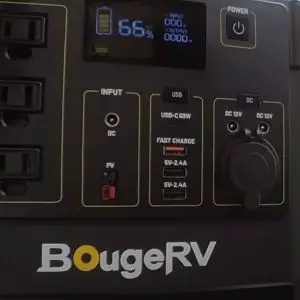The BougeRV 1100Wh portable power station can really come in handy, especially during energy emergencies. However, they do have the possibility of running into system errors. In this post, we cover some of the most common errors and ways to fix them.
Here they are:
Error 01
Cause:
The USB port started short circuit protection due to a short circuit inside the machine.
01 Solution:
Disconnect the charging cable from the device, or stop charging it. Press the USB button 2 x to stop it.
Error 02
Cause:
The QC fast charge short circuit protection has kicked in. This is due to a short circuit inside the machine.
02 Solution:
Disconnect the charging cable from the device, or stop charging it. Press the USB button 2 x to stop it.
Error 03
Cause:
The DC short circuit protection has kicked in. This is due to a short circuit inside the machine.
03 Solution:
Disconnect the charging cable from the device, or stop charging it. Press the DC button 2 x to eliminate it.
Error 04
Cause:
The AC inverter starts short-circuit protection. This is due to a short circuit inside the machine.
04 Solution:
Disconnect the charging cable from the device, or stop charging it. Press the AC button 2 x to eliminate it.
Error 05
Cause:
The AC inverter overload protection has kicked in. This is due to the electrical load exceeding the limits of the machine because of connected appliances rated > 1200 W.
05 Solution:
Do not connect appliances with power ratings > 1200 W. Press the AC button 2 x to stop it.
Error 06
Cause:
The AC inverter’s high-temperature protection has started due to the temperature exceeding 176℉.
06 Solution:
Press the AC button 2 x to stop it. To prevent this from recurring, only use the machine at an ambient temperature between 32°F to 105°F.
Error 07
Cause:
The battery’s high-temperature protection on the output has started. The output will be cut off
when the battery temperature exceeds 63 ℃ / 145°F.
07 Solution:
Press the AC button 2 x to eliminate it. Let the machine stand for a period of time until the temperature drops, so it
can output normally.
Error 08
Cause:
The battery has started low-temperature protection for the output. The output will be stopped when the battery
temperature exceeds -10℃ / 14°F.
08 Solution:
Press the AC button 2 x to stop it. Put the machine in an environment above 0℃ / 32°F, so that it can output
normally.
Error 10
Cause:
The battery’s high-temperature protection for the input has started. This will occur when the battery temperature exceeds 47℃ / 117°F.
10 Solution:
The machine will stop charging, and automatically restart when the unit’s temperature drops below 47℃ / 117°F.
Error 11
Cause:
The battery’s low-temperature protection for the input has kicked in. This occurs when the battery temperature drops below -3℃ / 27°F
11 Solution:
The machine will automatically restart charging when the temperature rises to over -3℃ / 27°F.
Error 12
Cause:
The input over-voltage protection has started. This occurs when the DC and PV input voltage exceeds 30V.
12 Solution:
Only use the original AC adapter to charge the machine. When PV charging, it is recommended to use ≤ 200W solar panels.
Error 13
Cause:
The battery’s low-voltage protection has started. The machine’s voltage will drop when the battery capacity is low. This will lead to the output is cut off, when the voltage is below 18V
13 Solution:
Charge the battery when the battery capacity drops below 10%. When the battery capacity is low, it is recommended to not use DC appliances for too long.
If any of the above-listed errors and fixes do not work and the problems persist, contact the dealer or manufacturer for further assistance.

